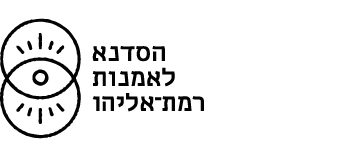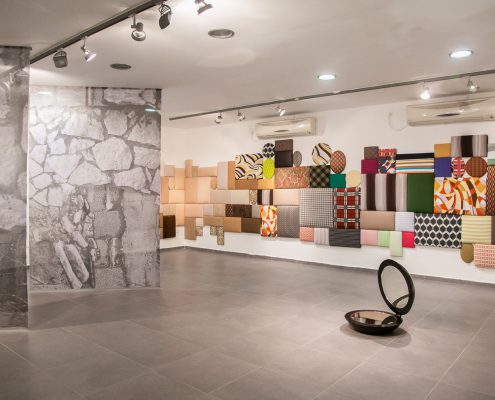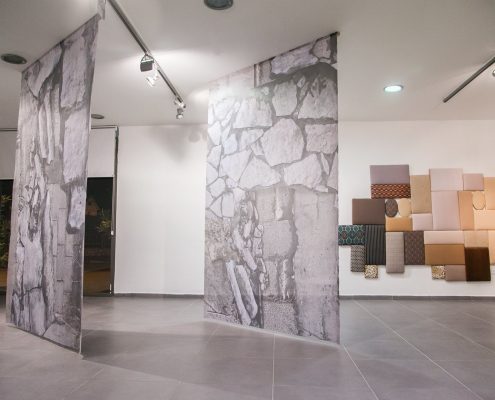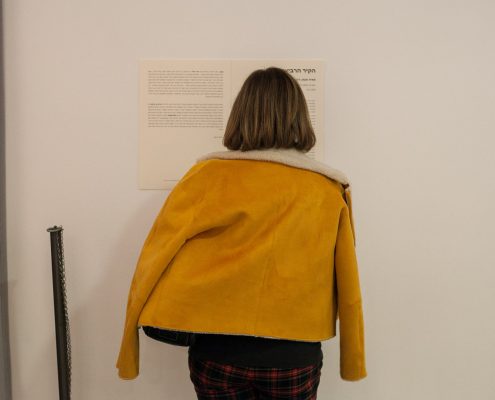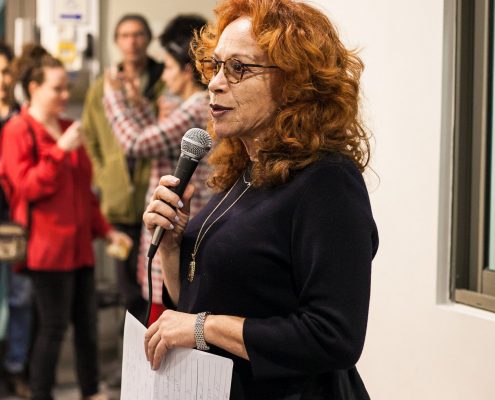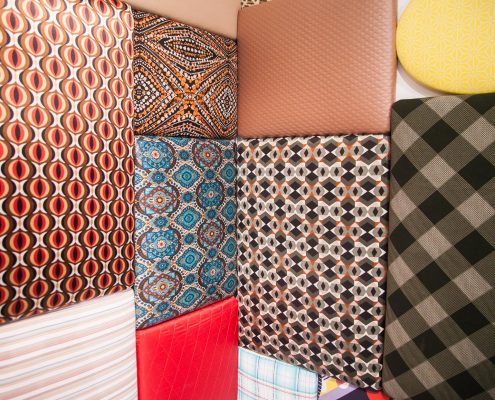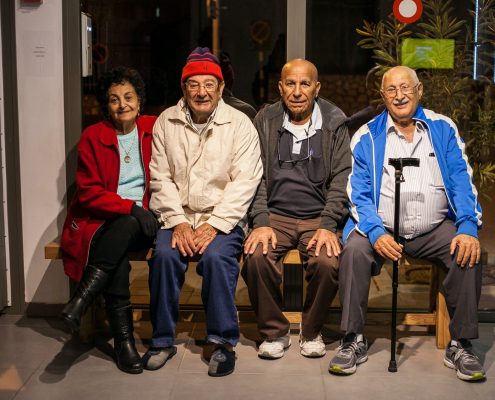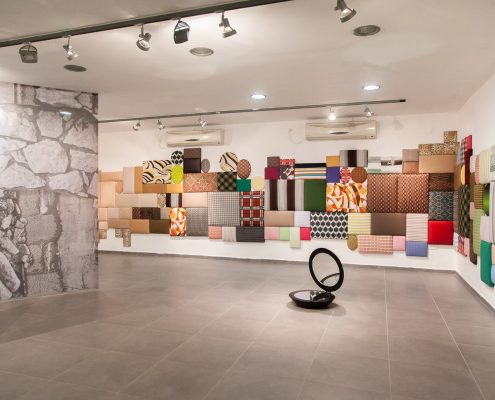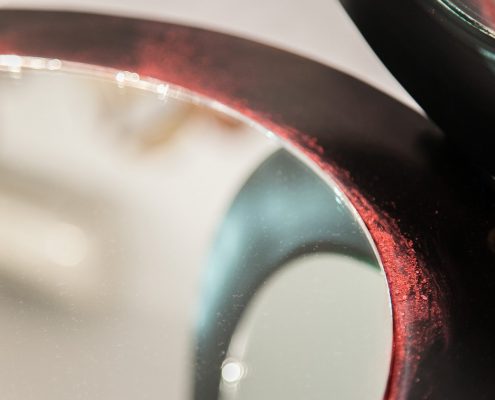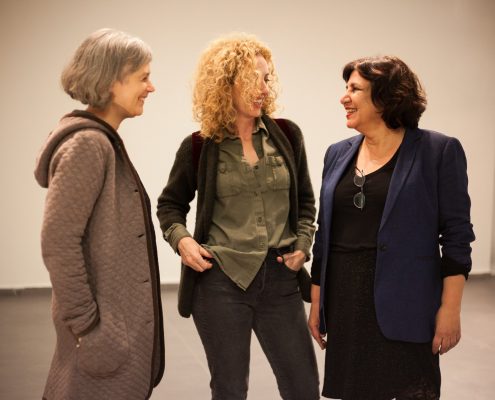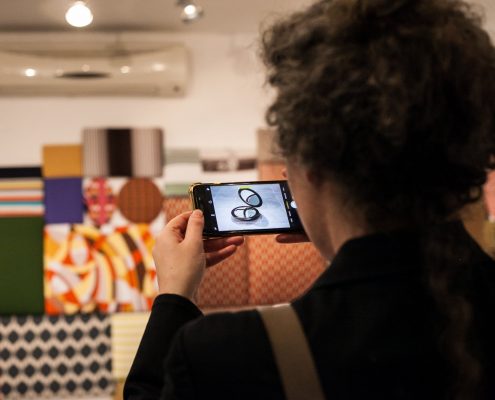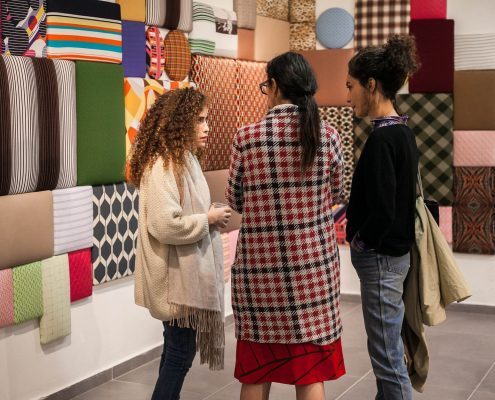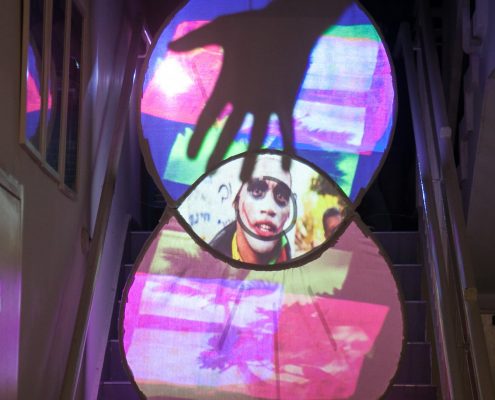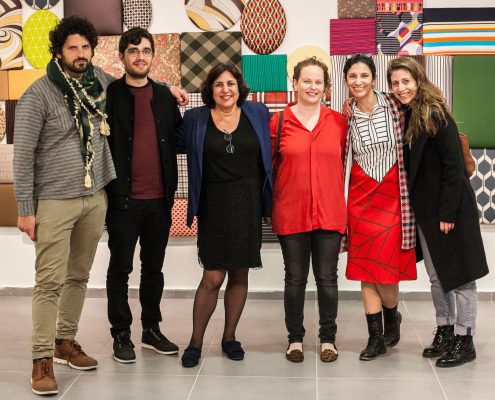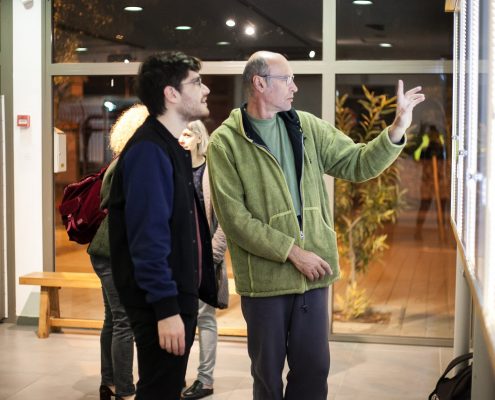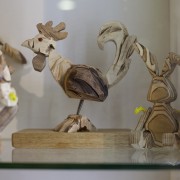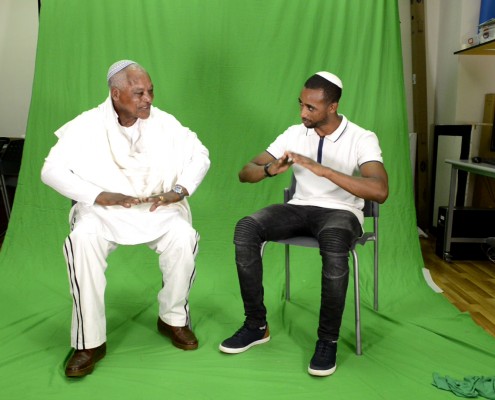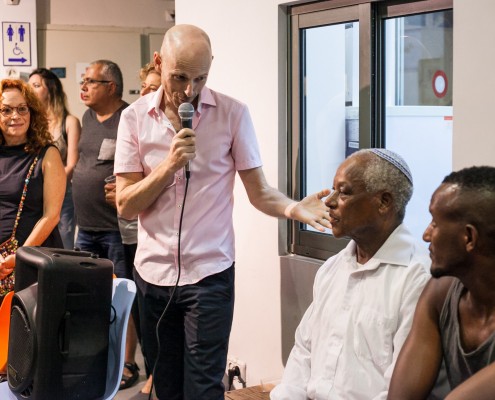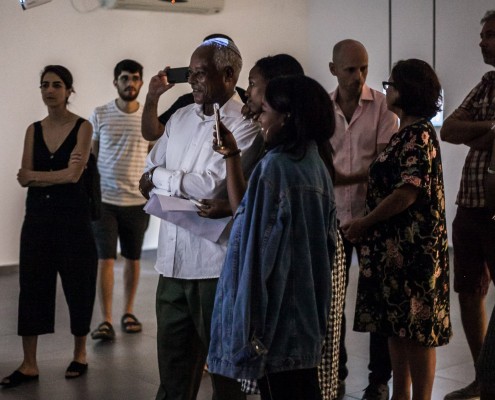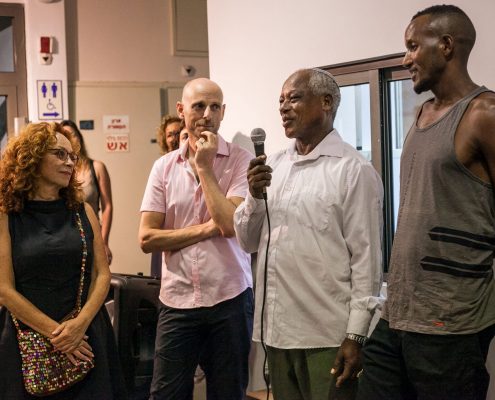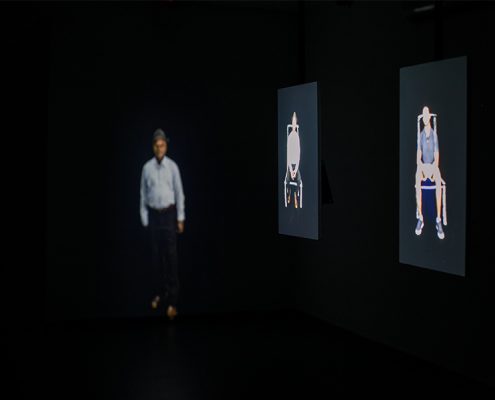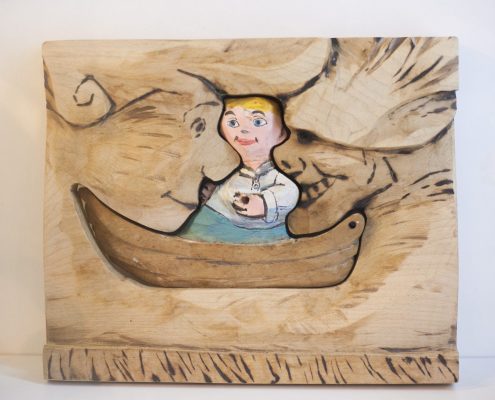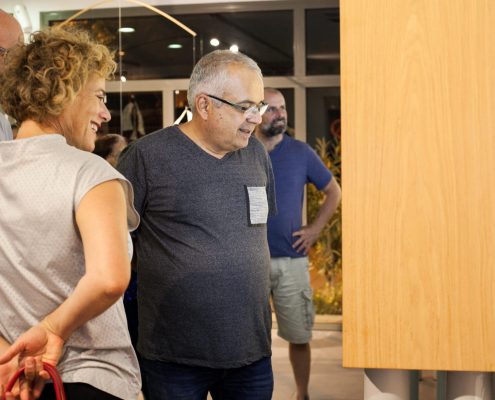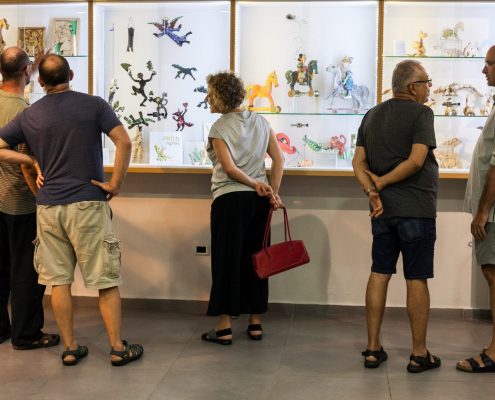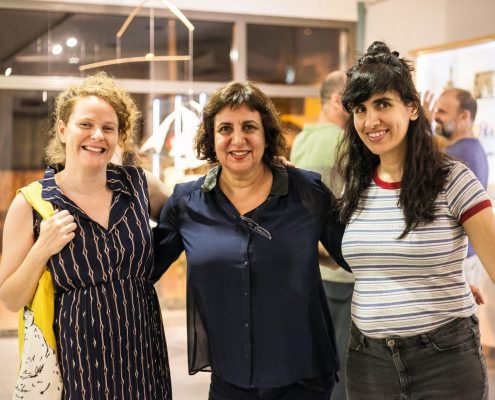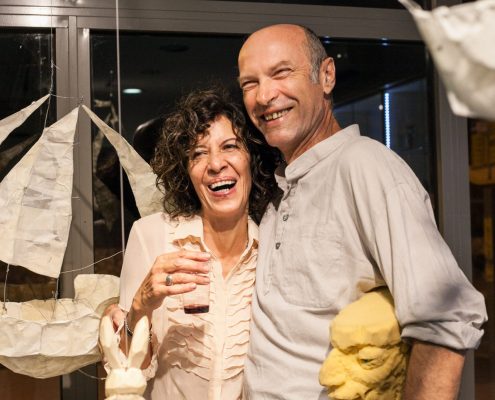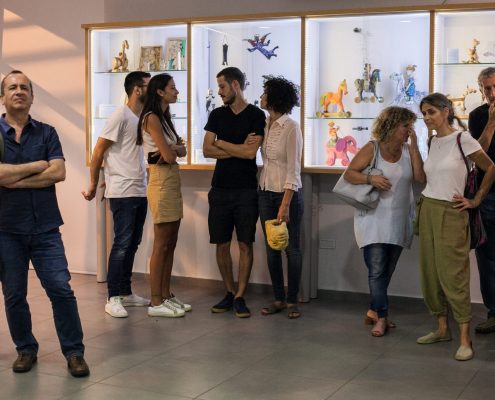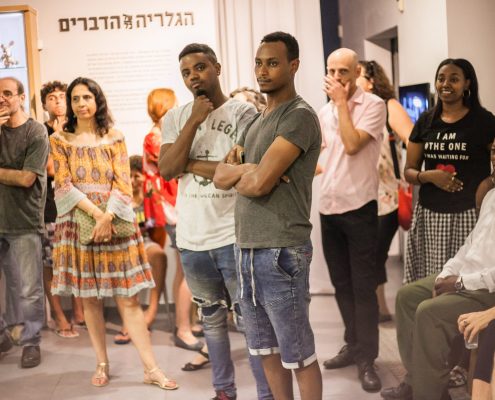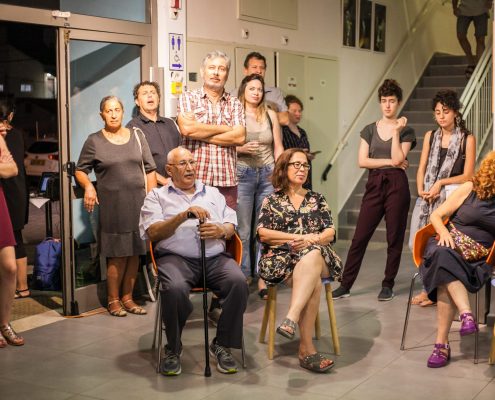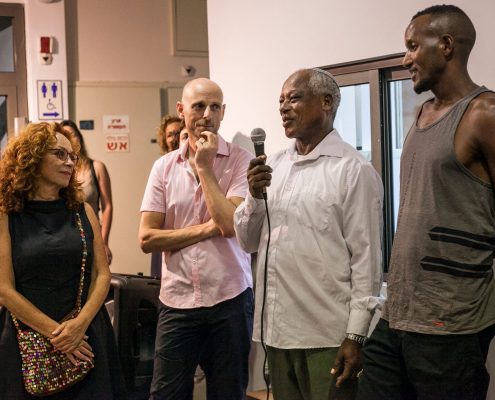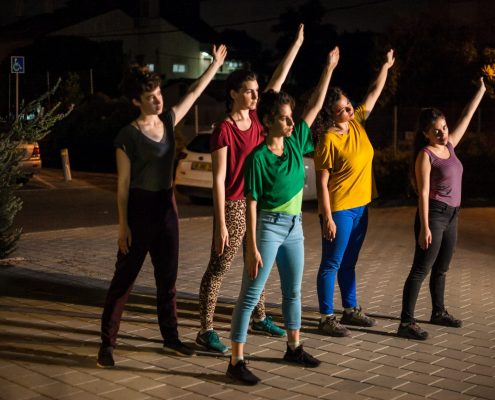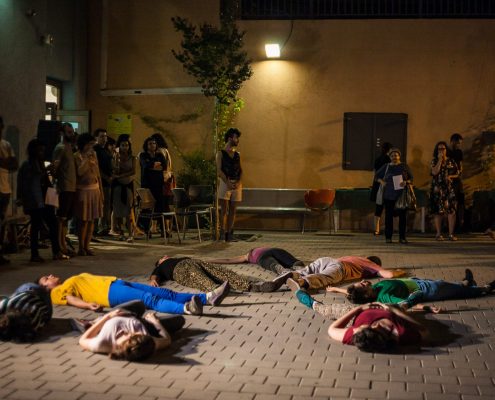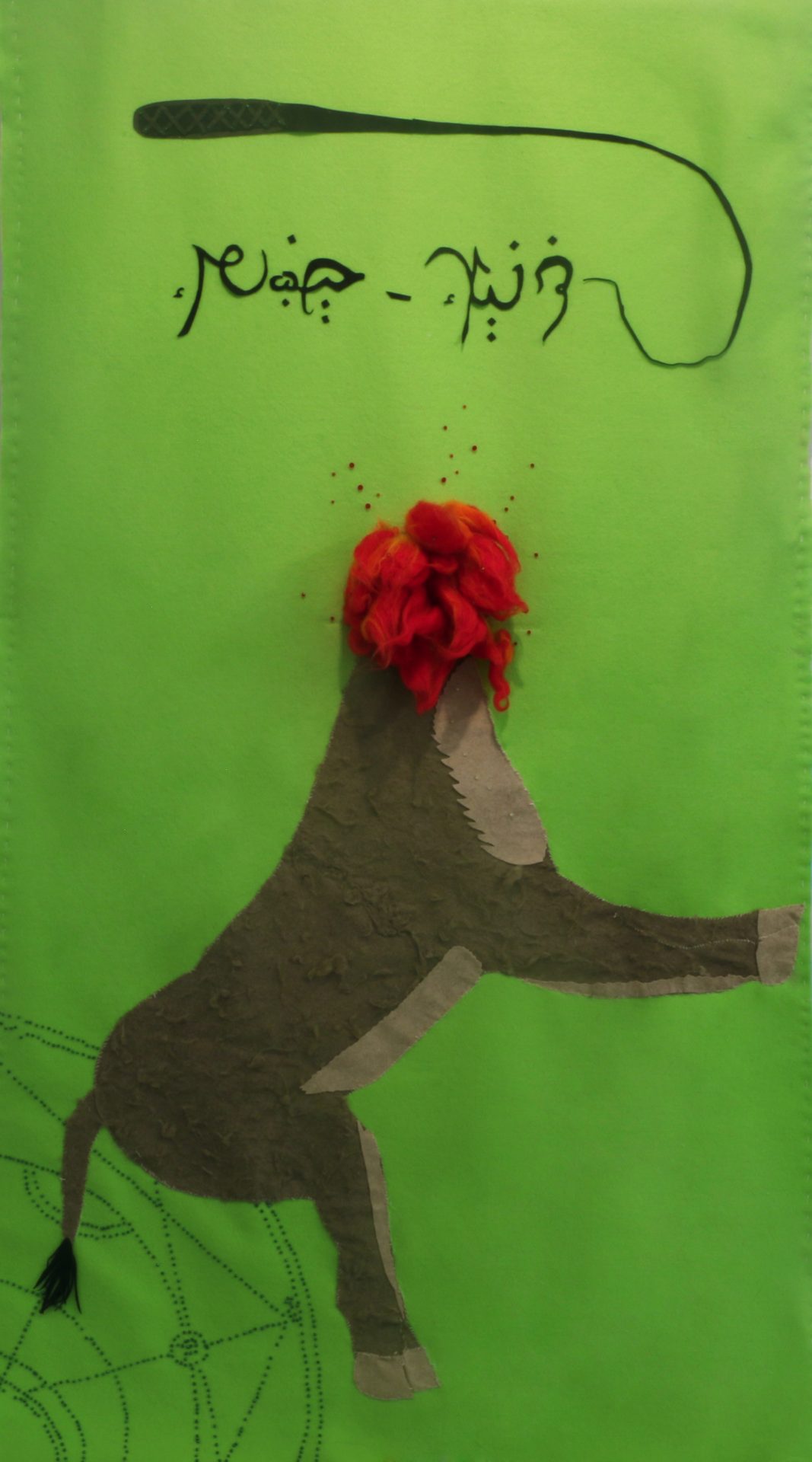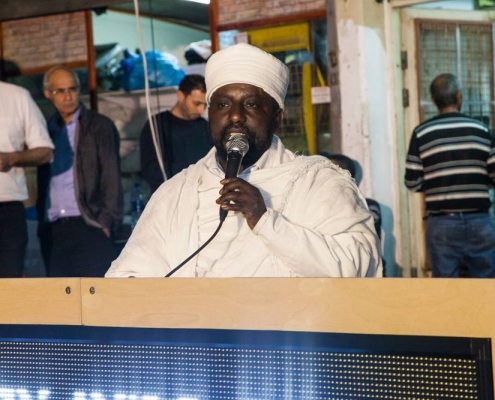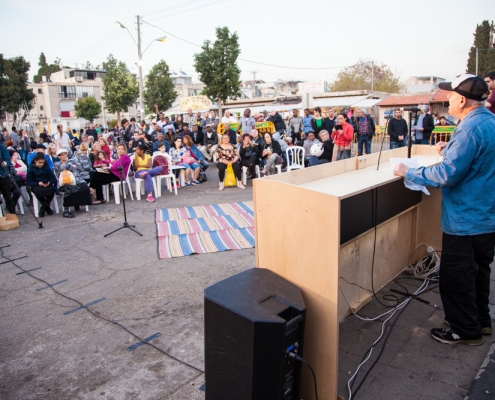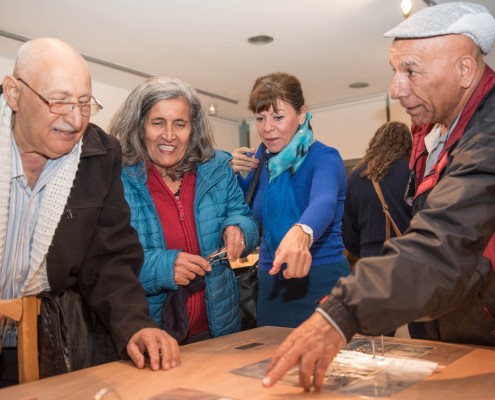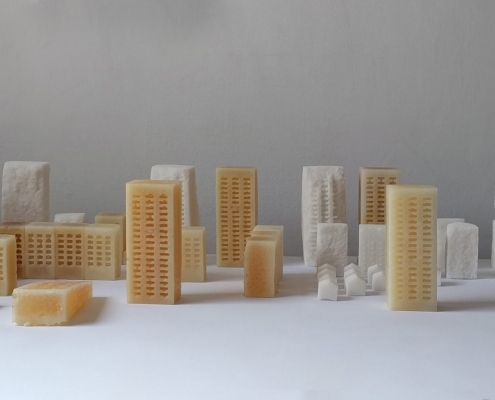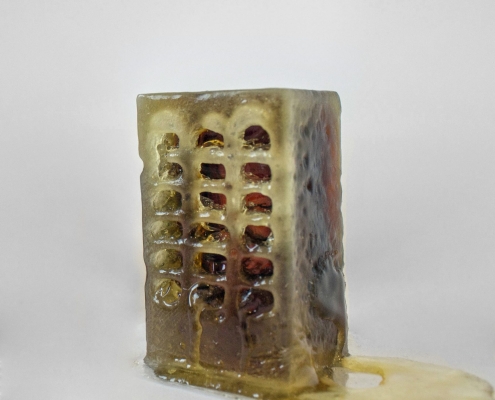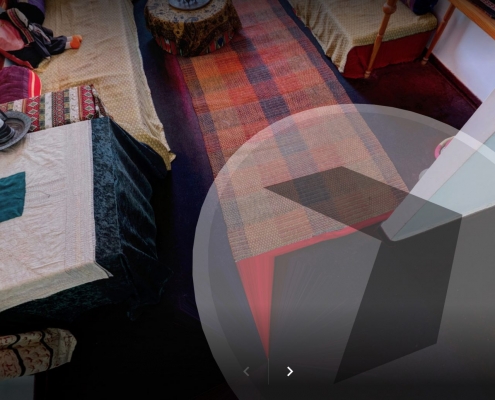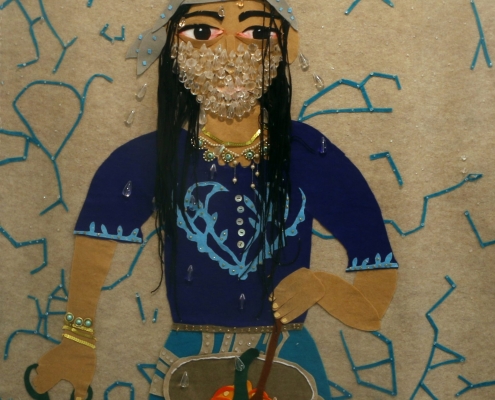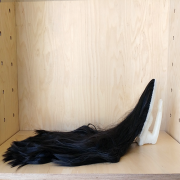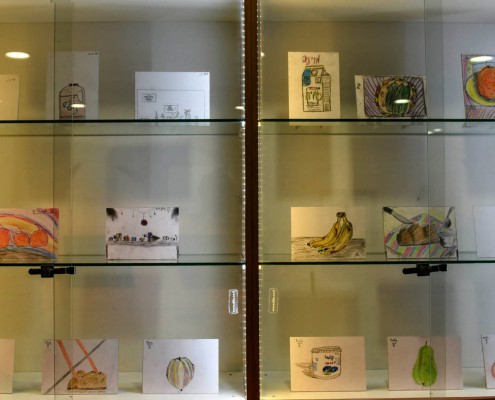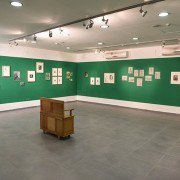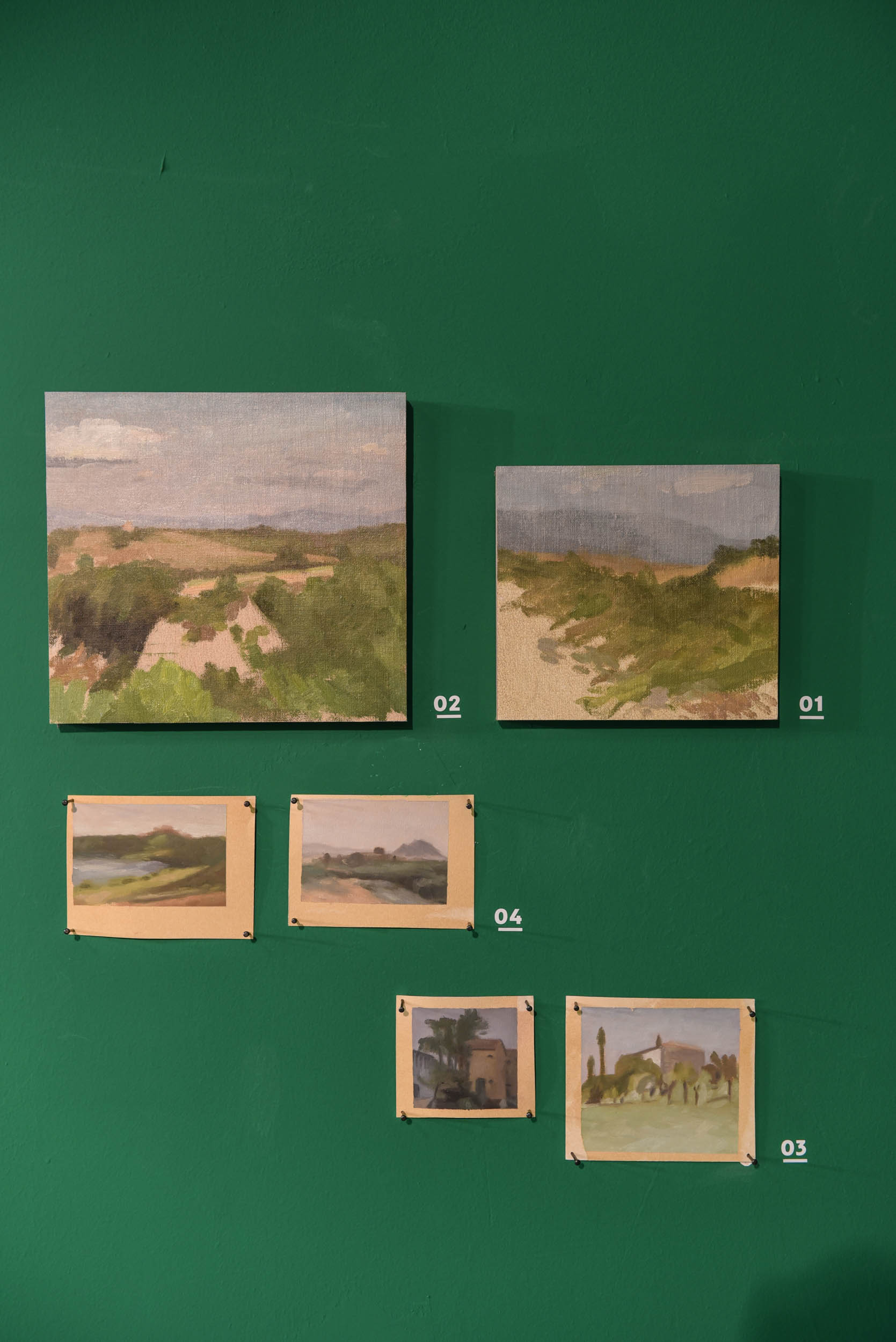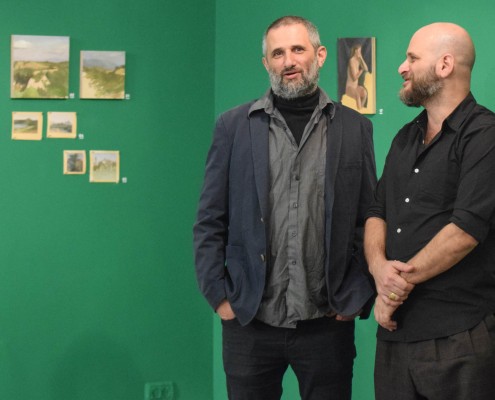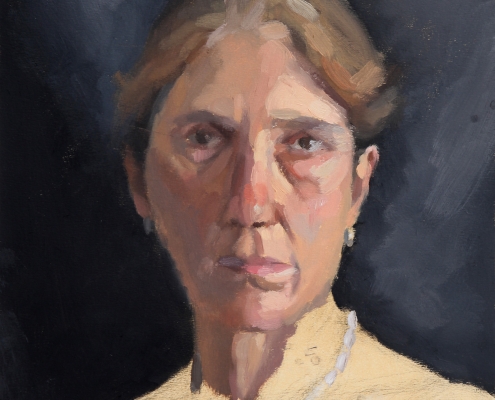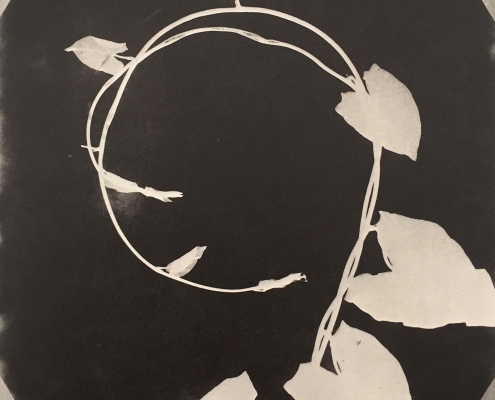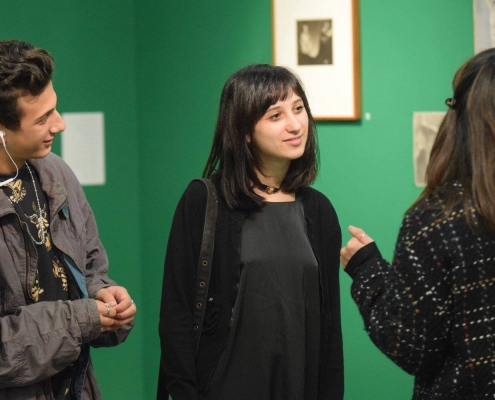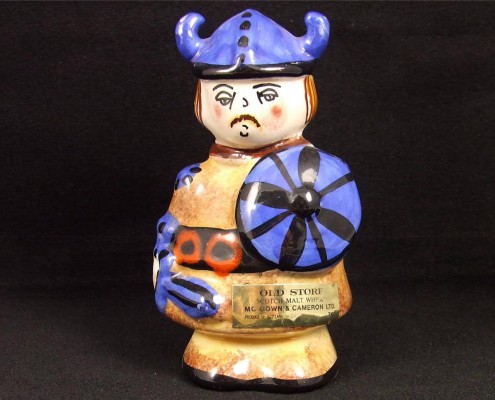הקיר הרביעי, תערוכה | The Fourth Wall, Exhibition
הקיר הרביעי
מאיה אטון, דגנית בן אדמון, דנה יואלי
אוצרות: אלפא חיימוב ואורית חסון ולדר
15.12.2018
*English follows below
“הקיר הרביעי” הוא מונח מתחומי התיאטרון והקולנוע המתאר קיר שקוף ובלתי נראה החוצץ בין הבמה או הסצנה המצולמת לבין הצופה. המונח נקשר למהות תערוכה זו שבה הפְּנים (של בית, של רגעים אינטימיים הרשומים בזיכרון) מתערבב עם החוץ (רחוב, זהות לאומית, דברים המוגדלים פי כמה וכמה ונראותם בולטת ומוחצנת). בתערוכה, הקיר הרביעי אשר הגן על הפְּנים מפני החוץ, מתמוסס ונעלם, והצופה כמו צועד פנימה אל התוֹך הרך והפגיע של עבודות האמנות.
הולדת התערוכה ברצון להתעכב על הממד הצוּרני-אדריכלי של שכונת רמת אליהו שבה נמצאים הסדנה וחלל התצוגה. הצורות, הצבעים והדגמים שקלטו שלוש האמניות במרחב הציבורי – חזיתות הבניינים, המבנים התעשייתיים והמרכזים המסחריים – הם נקודת המוצא של התערוכה. אחרי שסיירו בשכונה, תרגמו האמניות את שראו בהקשרים החברתיים, התרבותיים והפוליטיים שהם חלק מהשפה האמנותית הייחודית לכל אחת מהן.
שכונת רמת אליהו היא אחת מערי החולין(1): שכונת מגורים כמוה יש רבות, שכונות שבהן מתנהלים חיי היום יום ללא זוהר ומסתורין. החזית האפרורית המודרנית, היא מאיץ ליוזמות פרטיות זעירות של הוספת אזורי צבע חמים שנועדו לשפר את סביבת המגורים: צורות אדמדמות על סורג, החלפת מעקה מרפסת סטנדרטי במעקה דקורטיבי בצבעי בורדו, קיר ורוד-מסטיק המסמן מבחוץ דירה אחת במרכזו של בלוק דירות אפור.
מאיה אטון רואה בתוספות צבע ספונטניות אלה ניסיון להוסיף רעננות ויופי- כמו איפור הפנים בסומק בגוון ורדרד. הצבעים שדהו בשמש מכמירי לב, שריד לאיפור שנמחה ונמרח, ולחילופין מעלים על הדעת אדם שהסמיק, ומנסה בכל כוחו לא לבלוט. סומֶק, פסל הפודרייה שבנתה אטון, אביזר איפור אינטימי שהוגדל לממדים על-שימושיים, מצויד באבקת סומק בגוון ורוד עתיק הדומה לצבעים שמופיעים ברחובות השכונה. בפודרה הדחוסה מוטבע סמל גרפי הלקוח מקישוטים גיאומטריים שבהם הבחינה האמנית על חזיתות הבתים וכך מונצחת החזית הציבורית באבקה העדינה לשימוש אישי.
בְּקִיעַ, מיצב הדגלים הגדולים של דנה יואלי הוא תעתוע בין זיכרון אישי לאתוס לאומי. קירות רכים – ספק גדרות אבנים, ספק קירות הנצחה – שכמותם נמצא בכל עיר ובזיכרונות הילדות בארץ. יואלי מגדילה צילומים של שברי אבנים ובלוקים מקירות וגדרות בשכונת רמת אליהו ומדפיסה אותם על בד לשילוט חוצות. בין אבני הגדר המוגדלות חבוי דיוקן קטן של קיסרית האימפריה הביזנטית תיאודורה, כפי שהונצחה בפסיפס לפני מאות שנים בעיר וורונה שבאיטליה. הצילום היה תלוי בבית משפחתה של האמנית והוא מהווה עבורה זיכרון ילדות חשוב. האמנית הטמינה קטע מהדיוקן שנצרב בזיכרונה הפרטי – עין אחת, רבע כתר, ושליש מהפנים הקיסריות – בין האבנים והשברים של זיכרונות ילדות קולקטיביים. כמו הפודרייה של מאיה אטון שגדלה פי כמה, גם הדגלים התופסים את כל גובה חלל הגלריה מאירים רגע מוכר ובנאלי באור גדול. במעבר למדיום צילומי הפכה התחושה של אבן מחוספסת למשטח חלק, בעוד השברים והאבק של המיתולוגיה השכונתית מתמזגים עם ההוד וההדר של המיתולוגיות העתיקות.
כשהיא נזכרת בנסיעה לאורכם של הרחובות בשיכונים שבעיר ילדותה באר שבע, מדמיינת דגנית בן אדמון את חזית הבניינים הארוכה המסתירה מאחוריה עשרות דירות, כמוסות חיים המקודדות בדגמים, בצורות ובצבעים שבחדרי המגורים המשפחתיים ובחדרי השינה. הטקסטיל הביתי – הביגוד, הווילונות, המפות – מחצין את התשוקה לבלוט ולהתהדר במָקום שבו נוכחים דווקא חזרתיות אפרורית ושכפול. הבד, בהיותו חומר העוטף את הגוף מרגע היוולדו, מדבר בשפה אוניברסאלית של מגע וראייה מישושית(2) במיצב Inside-Out מייצרת האמנית, במהלך של טרנספורמציה מודרניסטית המערבת הפשטה וצורות גיאומטריות, “ארכיון בדים” שבאמצעותו היא חושפת בפני הצופים את פְּנים הדירות הבנויות זו לצד זו ובו בזמן מנכיחה את הרחוב- הפְּנים מושלך אל החוץ. כמו דנה יואלי, גם בן אדמון בונה קיר רך- אך בעוד הקיר הגמיש של יואלי נבנה על ידי הקצנה וחיקוי, בזיקה לזיכרון קולקטיבי של הנצחה ומיתוס לאומי, הקיר הרך והמרופד של בן אדמון נבנה כחפץ הגנה על יקיריה גם בידיעה שזהו חיקוי בלבד.
אלפא חיימוב
(1)ד”ר רועי ברנד, The Urburb – קטלוג הביתן הישראלי של הביאנלה ה- 14 לאדריכלות בוונציה (עורכים ר’ ברנד וא’ שלום), הוצ’ שטרנהל ספרים, 2014, עמ’ 276.
(2)את ההשראה לצמד מילים זה קיבלתי מתוך מאמרה של אירנה גורדון “החוש הטקסטילי”.
גורדון אירנה, (2015), החוש הטקסטילי, בתוך: ברטל,א’, זהבי ר’, ארליך ע’ (עורכים), מחשבות על קראפט (עמ’ 3387-406), תל אביב: רסלינג.
The Fourth Wall
Maya Attoun, Dganit Ben Admon, Dana Yoeli
Curators: Alfa Haimov and Orit Hasson Walder
Opening: Saturday evening, December 15, 2018
The Fourth Wall is a concept from theatre and cinema describing an invisible transparent wall dividing the stage or photographed scene from the viewer. The term is linked to the essential nature of this exhibition in which interiors (such as homes, or intimate moments engraved in memory) blend with the external (the street, national identity, enlarged several times to exaggerate their visibility and make them stand out). The “fourth wall” which protects the interior from the outside melts away and disappears in this exhibition, leaving the viewer to seemingly stride right into the artworks’ soft, vulnerable core.
The exhibition was conceived in the wish to take time to consider the aspect of architecture in the Ramat Eliyahu neighborhood, where the Art Workshop and Gallery are located. The forms, colors, and patterns that the three artists perceived in the visual public space formed by the residential, industrial, and commercial buildings constitute the exhibition’s point of origin. After touring around the neighborhood, the artists translated what they saw into the sociopolitical-cultural contexts that form part of each one’s unique art language.
The Ramat Eliyahu neighborhood is one of Israel’s “urburbs”[1] : a fragmented hybrid of urban and suburban, a residential neighborhood among many in which daily life goes about without any glamour or mystery. The modernist grey façade is a catalyst for small private enterprises in which residents have added areas of warm color designed to improve the environment, such as reddish forms of a window bar, a decorative burgundy-colored railing replacing a standard balcony railing, a bubblegum-pink wall marking the outside of a single apartment at the center of a grey cinderblock housing project.
Maya Attoun considers these spontaneous additions of color an attempt to add freshness and beauty – like adding pinkish rouge to the face. The colors that have faded in the harsh sunlight, remnants of makeup that smeared and was erased, often bring to mind a person who blushed but makes utmost attempt not to stand out. “Somek”[compact],Attoun’s sculpture made of shapes of makeup or blusher compacts, an intimate accessory enlarged to an unusable size, is filled antique rose blush similar to the colors appearing in the neighborhood streets. The dense powder is stamped with a graphic logo taken from the geometric decorations the artist noticed on the building facades, thus memorializing the public façade with the delicate rouge meant for personal use.
“Bekia” [splittable] the large flag installation by Dana Yoeli is an illusion between personal memory and national ethos, with soft walls which may be read as stone walls or perhaps walls of a memorial such as found in each Israeli city and in the childhood memories of most Israelis.Yoeli enlarged photographs of broken stones and blocks from walls and fences in the Ramat Eliyahu neighborhood then printed them on sheets used for large-scale outdoor billboards. Among the enlarged images of stones making up the wall is a small portrait of the Byzantine Empress Theodoraas commemorated in a centuries-old mosaic in Verona, Italy. The photograph was hanging in the artist’s childhood home, constituting an important memory for her. The artist hid a portion of the portrait, indelibly imprinted on her private memory – just one eye and a quarter of a crown, a third of her face – among the broken stones of collective childhood memories. Like Maya Attoun’sblusher compact enlarged several times, the flags are huge, taking up the full height of the gallery space, illuminating a familiar banal moment. The transition to the medium of photography transformed the sensation of rough stone surface into a smooth area while the fragments and dust of the neighborhood’s mythology blend with the glory and splendour of ancient mythologies.
Dganit Ben Admon remembers riding through the streets of Beersheva as a child, passing by the mass housing blocks. The memory evokes thoughts of how the long facades of the project concealed dozens of apartments. Filled with life, the housing blocks are encoded in the patterns, forms, and colors of the living rooms and bedrooms: domestic textiles of clothing, drapery, tablecloths, externalizing the passion to stand out and show some beauty in a place in which the repetitive greyness and replication are strongly present. Fabric, as material wrapping the body from the moment of birth, speaks in a universal language of contact and tactile vision[2].In her installation Inside-Out, the artist creates a “textile archive” through a modernistic her modernistic transformation blending abstraction and geometric shapes. Through this archive she reveals to the viewers the interiors of the apartments stacked up and placed side by side, while at the same time, making the street present in a process in which the interior is projected outward. Like Dana Yoeli, Ben Admon also builds a soft wall – but while Yoeli’s flexible wall was built through imitation and taking things to the extreme in its link to the collective memory of commemoration and national mythos, Ben Admon’s soft, upholstered wall has been constructed as an object protecting her dear ones, even though she knows that it is merely an imitation.
Alfa Haimov
[1] Dr. Roy Brand, in The Urburb: Patterns of Contemporary Living, Catalog of the Israeli Pavilion of the 14th Venice Biennale for Architecture, Brand, R. and A. Shalom (eds.), (Sternthal Books, 2014), p. 276.
[2] My inspiration for the term is from Irena Gordon’s article on “Woven Consciousness” (2015) in Mahshavot al craft (Thoughts on craft), Bartal , U., R. Zehavi, and E. Ehrlich (eds.), (Tel Aviv: Resling), pp. 387-406.
